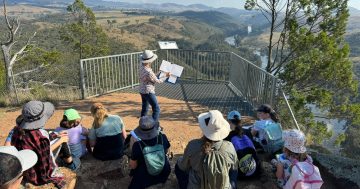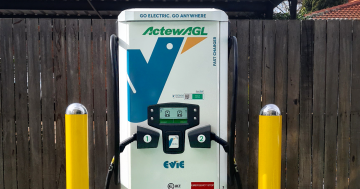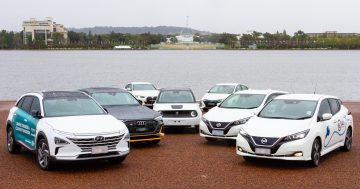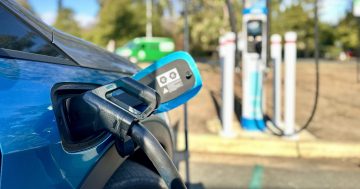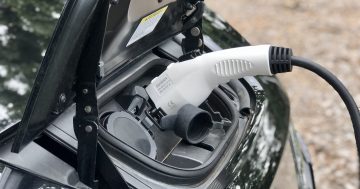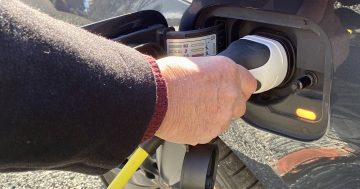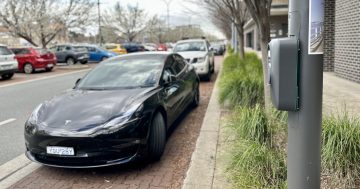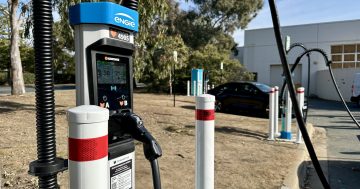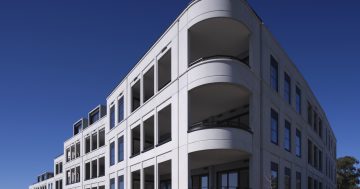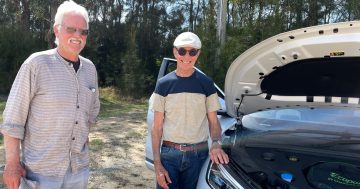
The Casey Market Town site is Evie Networks’ 200th site nationally, a milestone celebrated by CEO Chris Mills (left) and Water, Energy and Emissions Reduction Minister Shane Rattenbury. Photo: Supplied.
Casey Market Town is the latest Canberra location to be fitted with fast chargers as the electric vehicle (EV) uptake continues accelerating in the capital.
The four new charging bays, powered by two DC fast chargers from Evie Networks, are the first for the area.
Water, Energy and Emissions Minister Shane Rattenbury said while 12 to 18 months ago the ACT had been lagging when it came to EV charging infrastructure, the Territory had cleared the backlog.
“Certainly, I’ve seen fewer complaints coming in recent times … about the lack of charging infrastructure,” he said.
“We are seeing a growth in [electric] vehicles, so we need to keep increasing the number of charging [bays] available.”
There are already 160 charging bays across the ACT, powered by 135 chargers, provided by government and private enterprises.
The government wants to have 180 chargers built by 2025.

Four charging bays are available at Casey Market Town. Photo: Supplied.
Mr Rattenbury said the focus was on making sure chargers weren’t just located in Civic and town centres but were also available in smaller precincts.
He highlighted Casey Market Town as an example where the business’s initiative was meeting customer demand.
“This is something businesses across Canberra should be having a look at. Customers out there need to be able to charge their cars. They’re looking for the convenience,” Mr Rattenbury said.
“This is a terrific opportunity. You can pull up here, charge your car while you go across the road, do your shopping and have a coffee.
“There’s a good selection of shops here, and people can easily come and charge their vehicle while going about their weekly or daily business. That is an ideal set-up. That’s exactly the kind of convenience we want.”
The Casey Market Town chargers are suitable for all types of EVs with CCS2 and CHAdeMO plugs, joining government-funded DC fast charging sites at the Royal Australian Mint and Hotel Realm.
However, there has been criticism that higher-density areas like Belconnen are missing out on public chargers.
The government has launched the Residential Strata EV Ready Pilot Study to explore installing EV chargers in apartment buildings, but Mr Rattenbury acknowledged not everyone could charge at home and that more infrastructure needed to be rolled out.
It’s not clear where the next public chargers will be built, but Evie Networks CEO Chris Mills said preparations were underway to build in Deakin and across the border in Queanbeyan.
“Certainly, with the more progressive policies coming out across [all levels] of government, we are seeing the take-up of electric vehicles is accelerating,” he said.
“Getting the infrastructure out there to give [people] the confidence, not only of the availability of the network but also the geographic spread, is really important.”
Technologies are continuing to progress in the EV space, with Toyota previously signalling it wanted to roll out solid-state battery EVs globally before 2030.
These batteries are projected to last longer and take less time to charge than current options.
This has raised questions about what reinvestment might be needed in the EV charging space.
But Mr Mills said not all chargers will need to be replaced as technology changes.
He explained some places are more suited for slow chargers, such as outside restaurants or movie theatres, while highways would be places where faster charging would be expected for a “petrol-like experience”.
“So there’s a use case for each of those various types of chargers, so you don’t necessarily look to replace all existing ACT chargers [as things change],” Mr Mills said.
“That said, for us to change ACT chargers to make them faster in those locations that make sense … we would need to look at the availability of the electrical connection and whether or not the infrastructure would support the increased speed of the chargers.”
As for what’s available now, he said the Casey location ticked the boxes needed for customer experience when charging – it was safe and secure, accessible, and with good lighting and amenities while charging.
“It’s a paradigm change from petrol, where you went to the petrol station to get your petrol,” Mr Mills said.
“Now you do your shopping, and while you’re there, you get your charge.”












